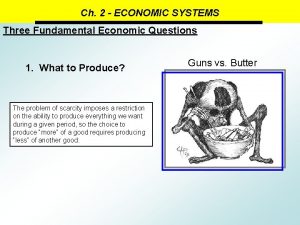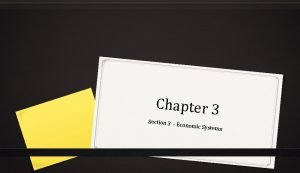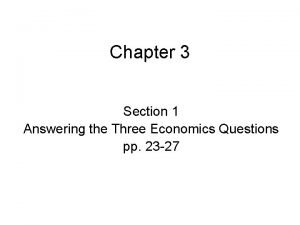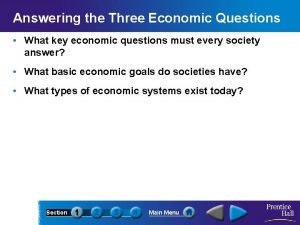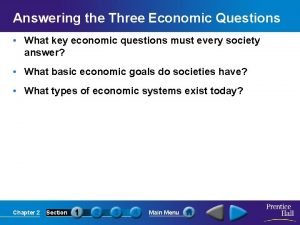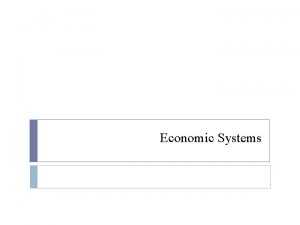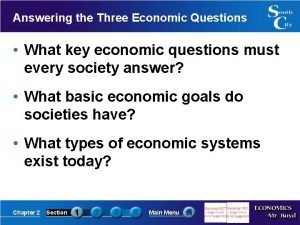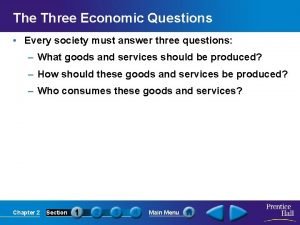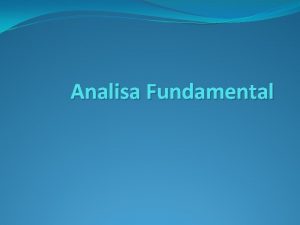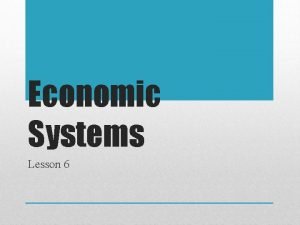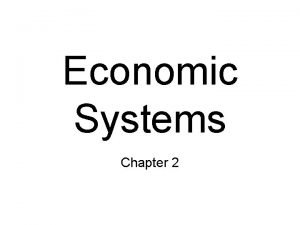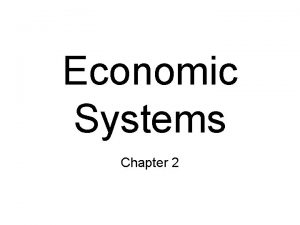Ch 2 ECONOMIC SYSTEMS Three Fundamental Economic Questions









- Slides: 9

Ch. 2 - ECONOMIC SYSTEMS Three Fundamental Economic Questions 1. What to Produce? The problem of scarcity imposes a restriction on the ability to produce everything we want during a given period, so the choice to produce “more” of a good requires producing “less” of another good. Guns vs. Butter

Ch. 2 - ECONOMIC SYSTEMS Three Fundamental Economic Questions 2. How to Produce? Vs. How do we mix technology and scarce resources in order to produce goods and services?

Ch. 2 - ECONOMIC SYSTEMS Three Fundamental Economic Questions 3. For Whom to Produce? Society must have a method to decide who will be “rich” and who will be “poor”.

Ch. 2 - ECONOMIC SYSTEMS 5 Economic Goals Economic Efficiency Making the most of resources Economic Freedom from government intervention in the Economic Freedom production of goods and services Economic Efficiency Assurance that goods and services will be available , Economic Security payments will be made time, and a safety net will Economic Security andon Predictability and Predictability protect individuals in times of economic disaster Economic Equity Fair distribution of wealth Economic Equity Economic Growth Innovation leads to economic growth, and economic Economic Growth andstandard Innovation growth leads to a higher of living and Innovation

Ch. 2 - ECONOMIC SYSTEMS Traditional Economies Relies on habit, or ritual to decide how to answer the 3 economic questions. • Revolves around the family • Work divided along gender lines • Agricultural and hunting practices usually dominate the economy • Slow to adopt new technology or ideas

Ch. 2 - ECONOMIC SYSTEMS Centrally Planned (Command) Economies The government owns both the land capital and decides on behalf of the people how to answer the 3 economic questions • Government controls all aspects of production • Socialism – government owns some FOP • Karl Marx – The Communist Manifesto

Ch. 2 - ECONOMIC SYSTEMS Free Market Economies Individuals and privately owned businesses own the factors of production and decide how to answer the 3 economic questions • Specialization of tasks makes the economy more efficient • Everyone acts in their own self-interest • There is no government intervention • Laissez Faire Adam Smith’s Invisible Hand Self-interest and competition work together to regulate the marketplace

Ch. 2 - ECONOMIC SYSTEMS Circular Flow of Money ents ym r Pa acto F $ Factor Market $ wa inte ges, r e res t, p nt, rofi ts $ $ $ F. O. P L. L. C Households Businesses Supp ly $ $ s and Good es servic Product Market $ Expe nditu res $ $ nd a Dem

Ch. 2 - ECONOMIC SYSTEMS Mixed Economies The people answer the 3 economic questions with some intervention from the government to account for market failures • Economic decisions are made by individuals with government oversight • Government is a key component of economic activity • All nations exist in the “mixed economy continuum” Centrally Planned Free Market Iran N. Korea Cuba France Russia Peru United Kingdom Canada United States Singapore
 The three fundamental economic questions
The three fundamental economic questions Five fundamental questions
Five fundamental questions Lesson 2 our economic choices
Lesson 2 our economic choices The three economic systems
The three economic systems Economics chapter 3 section 1 answer key
Economics chapter 3 section 1 answer key Three economic questions
Three economic questions Chapter 2 section 1 answering the three economic questions
Chapter 2 section 1 answering the three economic questions Three basic economic questions
Three basic economic questions Chapter 2 section 1 answering the three economic questions
Chapter 2 section 1 answering the three economic questions 3 basic economic questions every society must answer
3 basic economic questions every society must answer
